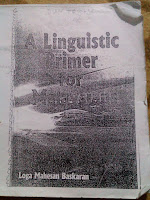Introduce
to linguistics
What is
language???
What is
linguistics???
Language can be seen as sound
organized into units of from and function with meaning,contextualized in
reality.
Who is
linguist???
Linguist;people who are
specialist in linguistics
What are the
fields in linguistics???
Pure
Linguistics
1.Phonetics
As soon as a
child is born he or she starts communicating.Babies communicate in many
ways;they coo and cry.At this stage babies send and receive numerous messages
vocally and non vocally.
2.Phonology
At this
stage,children are more productive and will start combining sounds to produce
syllables that carry meanings.It may or may not be something that you can find
in dictionary,but child's parents will definitely be able to comprehend the
'words'.
3.morphology
At this
stage,children will begin to combine syllables to from words that carry
meanings and has relation to his or her environment.The words are normally used
as a sentence and something carries more than one meaning.
4.Syntax
This is
the stage that a child learns to combine words to communicate his thoughts.They
will be able to combine to words together and produce words like 'big
toy','baby shoes',and 'baby mum mum'.Children at this stage may even come out
with simple sentences like "baby want milk"
5.Lexicology
At this
stage children learn to use more words.if before this they only produce
concrete nouns now at this stage they will be able to use more abstract nouns
Example:"eat,drink,cat".
6.Semantics
Children
at this stage are already capable of producing words which have various
definition and meaning relationship.If before this they called all flowers as
‘flower’,now they would be able to differentiate them as orchid,rose and sun
flower.They will also understand that the word ‘bear’ can have different
meanings in different context.
Applied
linguistics
1.Education(teaching,learning,acquisition,assessment)
2.Linguistics
(The
study of the nature,structure,and variation of language,including phonetics,phonology,morphology and the study of human speech,language form,language meaning ,and language in context
3.Anthropology (the scientific
study of the origin and behavior of man,including the physical,social,and
cultural development of societies and cultures).
4.
Psychology
(the science of mind and behavior,and the application of such knowledge
of various spheres of human activity,such as education,health,occupational and employment services.
5.
Sociology
(the scientific study of human social behavior and the study of
society)
· 6. Clinical Linguistics (analysis and
treatment of language disorders)
· 7. Language
Acquisition
· 8.Teaching and
Learning Foreign Languages (developing foreign language teaching methods
· 9.Educational
Linguistics (the
use of the mother tongue in school)
· 10.Lexicography (theory and
practice in organizing dictionaries;methods and techniques for creating dictionaries
· 11.Computational
Linguistics (the
use of computers in language analysis and use)
· 12.Machine Translation( computerized
translation )
· 13.ASR –Automatic
Speech Recognition
· 14. Language assessment(to
measure student learning of languages,to determine
what a student
knows and/or can do and how well instruction is proceeding).
· 15.Forensic
Linguistics (the
application of linguistic knowledge,methods and insights to the context of
law,language,crime investigation,trial,experts,court,evidence,law,
jurislinguistique)
· 16.Data Mining (the process of processing
large volumes of data usually stored in a database and searching for patterns
and relationships within that data. It is automatic extraction and processing
of data)
· 17.Language pedagogy
(theory of developing teaching methods )
· 18.Psycholinguistics
(the
study of the psychological factors that enable humans to
acquire,use,comprehend and produce speech,relationship between language and
human behavior)
· 19.Internet
linguistics (It studies new language styles and forms that have arisen under the influence
of the Internet and Short Message Service (SMS)
· 20.Sociolinguistics (study of the link
between language and society)
· 21.Neurolinguistics (describes the
application of linguistic theories to the classification and analysis of
acquired disorders of language or speech in patients with brain damage)
· 22.Language
interpretation (facilitating
of oral or sign language communication between users of different languages)
· 23.Corpus linguistics(the study of
language as expressed in samples (corpora) or "real world" text ;it
is approach to deriving a set of abstract rules by which a natural language is
governed or else relates to another language)
· 24.Text Analysis (written discourse)
· 25.Language,culture,and pragmatics(cultural aspects in language teaching in intercultural
communication)
· 26.Language Control /
Dialectology(study
of linguistic dialect,variations in language and is based primarily on
geographic distribution;divergence of two local dialects from a common
ancestor and synchronic variation)
sumber
Buku A Linguistic Primer for Malaysians oleh Loga Mahesa Baskaran
